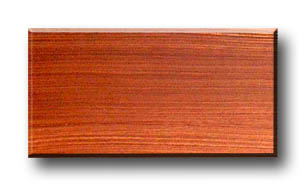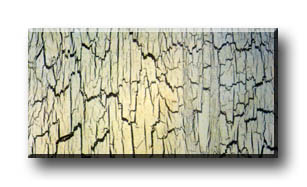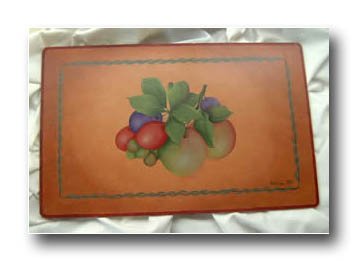Basic
Faux Finish Techniques
The creation of faux finishes in decorative
painting can be accomplished using a number of basic techniques.
These techniques are sometimes combined or used together to achieve
the desired effect. More sophisticated techniques may be applied
for some specific effects.
Sponging on 
Paint in a second color and of thin consistency
is applied to the basecoated surface by pouncing or dabbing it
on using a sea sponge. The ragged edge of the sea sponge, dabbed
at random and changing directions, produces a mottled effect
on the surface. Sponging-on may be used to create the variegated
background for a marble effect. Sponging off 
Another method of sponging where the paint
in a second color is mixed with some glaze to give it transparency,
applied to the basecoated surface thickly and removed by dabbing
a sea-sponge randomly or by using a crumpled piece of cling-wrap.
Sponging-off is used to create a leather effect. Smoking 
A technique to create a mottled, marbled effect
on a light background. The surface is first basecoated in a light
color like off-white or a light gray. It is then exposed systematically
to the soot of a burning candle. Once completed, the surface is
sealed using a spray sealer or varnish before further decoration. Stippling 
Paint in a second colour is applied over a
dried basecoated area by dabbing a stiff brush up and down creating
fine dots overlapping each other while still allowing the basecoat
color to show through. Stippling can be used to create the background for painting a design
or as one of the effects in an Intarsian Painting project. An old battered brush is the
perfect tool. Or you can use a deerfoot stippler or a stiff bristle brush.
Woodgraining 
Various types of woodgraining effects may be created. The most simple woodgrain above can be created using a variety of tools
including commercially manufactured graining combs, a small piece
of corrugated cardboard, a comb cut out of a cardboard or simply
a thick and stiff bristle brush. The surface is frist basecoated in off-white, yellow ochre or even a very light brown. A darker brown like burnt sienna or burnt umber
is mixed with some glaze. If using a thick bristle brush, it is
loaded with the glazed mixture and pulled repeatedly in a straight line overlapping the previous one. This technique creates a basic straightgrain.

This more complicated oakwood grain can
be achieved using a paintbrush followed by a flogger to soften the edges.
Crackling 
Crackling to get an aged look can
be done using 2-step crackling mediums. The surface to be crackled is
basecoated, dried, then crackle medium applied and allowed to
dry. A second, contrasting colour is painted over the crackle
medium and cracks appear almost immediately, revealing the basecoat
colour. Once completely dried, a design can be painted on it. There are also crackling mediums which can be brushed over the entire painted design of a project
- this produces fine porcelain crackle similar to that seen in old chinaware.
Antiquing 
There are many ways of antiquing using water-based
paints or oil paints. Water-based antiquing can be done on a
basecoat before the design is painted. The chosen colour is mixed
with
glaze and retarder and applied with a broad brush in loose strokes
where the aged look is desired. A mop brush is used to soften
the edges. Oil antiquing is usually done after the entire design
is painted and completely dried. Lean medium or linseed oil is
applied with a clean cotton rag to the desired area and burnt
umber oil paint is then applied. in a circular motion. A clean
rag is used to remove the excess oil paint to achieve the desired
effect.
|